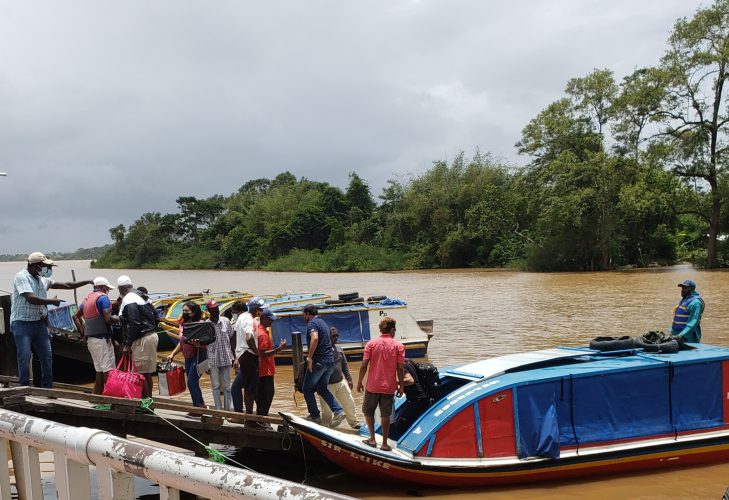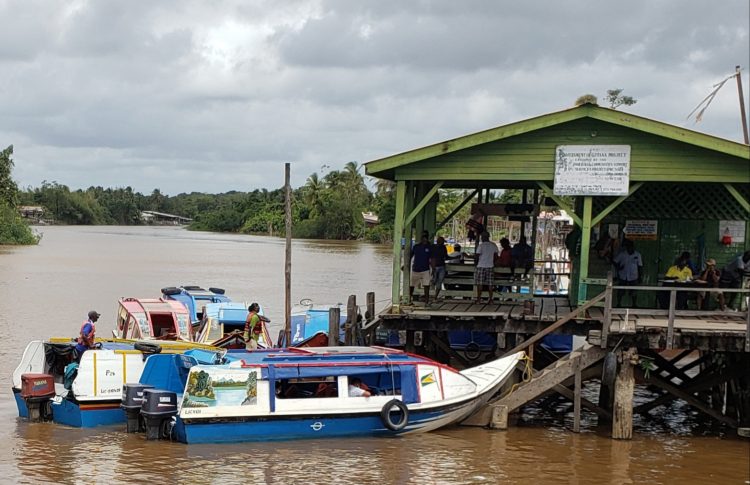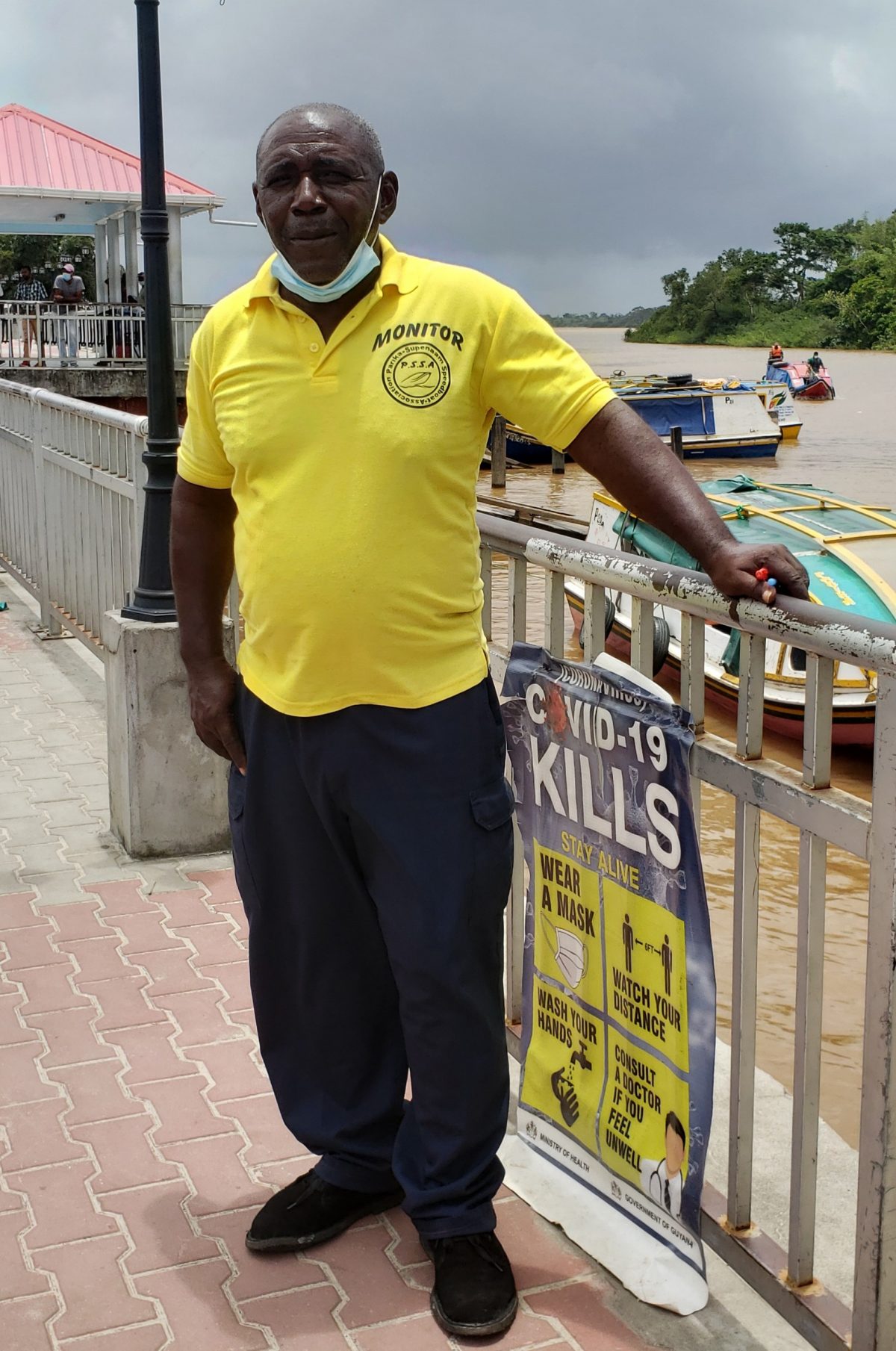While the boats load at the Supenaam Stelling, some of the operators and bowmen await their turn by playing cards under one of the sheds overlooking the water. They are occasionally joined by taxi drivers who are awaiting the boats. As the boats dock, taxi drivers shout out to passengers, asking where they are going as they, too, ply their trade. Overseeing it all is Colin Roberts, 61, who is the monitor at the stelling and is responsible for ensuring order is maintained in the operations of the speedboats that ply the Supenaam to Parika route on a daily basis. As a boat arrives or departs, Roberts can be seen at a desk making notes. “If it weren’t for us monitors on the wharves at Supenaam and Parika, there would be chaos and confusion as speedboat operators would be fighting for passengers as used to happen in the past when there was no system in place,” said Roberts during a recent interview at the Supenaam Stelling, in Region Two (Pomeroon-Supenaam).


“Back in the days, it was horrible. Boatmen used to pull and tug at passengers. Carry away their luggage. Sometimes passengers had no choice as to who they will travel with. Today we ensure boats are loaded according to rotation.”
The oldest of the four monitors employed by the Parika-Supenaam Speedboat Association (PSSA), Roberts is the longest serving monitor having worked on the job since the posts were created over 20 years ago. “Life has not always been smooth sailing but thankfully the waters I worked on have never been that rough that I should complain,” Roberts, a man of few words, told Stabroek Weekend.
Being on the waterfront, a strategic location, he said, he has met many people from different walks of life. He has helped and continues to help some people in different ways, even if it is with a meal or provide accommodation for a night to a stranded passenger, or simply helping someone with directions to get from one place to another. It appeared from the interview that he keeps a mental note of passengers who travel regularly.
He has gone from captaining a lumber boat in the Supenaam Creek to pork-knocking in the interior, to becoming a bowman on a speedboat from Supenaam to Parika, then to selling food at the Supenaam Stelling to make ends meet, before taking up the role of monitor.
A “transplant” in Supenaam, Essequibo Coast, Roberts was born in Bartica and moved to Supenaam at the age of 20 looking for a way to earn a living.
“I came to Supenaam. I met a woman I fell in love with. I married her and I settled down.” He is the father of five children, including two sons, who are boat captains in charge of boats on the route he monitors.
“My sons, who are boat captains, were professionals in other fields. One was a soldier and the other was a teacher. I think they weren’t comfortable in those professions. They are doing pretty well right now. The one who was a teacher, Otis, is now the president of the PSSA. I am proud of him. As a matter of fact, I am proud of who all my children have become.”
Roberts has seen the transformation of Supenaam from a sleepy logging community with rickity stellings to a bustling village worthy of being a township with a paved main road and a new Transport and Harbours Department (T&HD) wharf to dock its ferry.
“It is now the main hub with links to many villages on the Essequibo Coast, up the Supenaam River and to the Pomeroon River and the North West by road and river.”
Falls boat
After moving to Supenaam, in the 1980s and 1990s, Roberts worked as the captain of a ‘falls boat’ that transported lumber from Yapanani, where the logs that were cut in the interior were dropped off. Yapanani is some 25 miles up the Supenaam River. The lumber was then transported to the timber company A Mazaharally and Sons’ sawmill at the mouth of the Supenaam River on the Essequibo Coast. The ‘falls boat’ was engine-powered but was steered manually by two big oars (paddles) at the stern of the boat, and an oar at the front, which was used for maneuverability. Oarsmen were employed for this task. The ‘falls boat’ was a big ballahoo (flat-bottomed boat), with cross beams at the front and back of the boat on which the lumber were tied with chains to prevent it from falling into the river.
“I was in charge of one of these vessels. We collected greenheart, purpleheart, cabucalli, mora and all types of hardwood for the construction of wharves, buildings and you name it. You can say I made my contribution to the construction industry. At times the work was challenging, especially during the dry weather when we had to wait on the tide for water to rise and the boat to move without getting stuck.”
When A Mazaharally and Sons closed its operations in the 1990s, Roberts sought his luck in the goldfields as a pork-knocker. Being away in the goldfields for long periods on end was taking its toll on his family life. With his children growing up and needing his presence, Roberts said, he had to look at alternative employment on the home front.
He and his wife decided to cook and sell food at the Supenaam Stelling. “There was a need for snacks and actual meals for people who were travelling from all over the place. Some were travelling before the break of day and they needed sustenance.”
At that time, he noted, business was brisk as there was a shift in the commuting public who were beginning to use the speedboat service, which had just come into operation.
This speedboat service came about because of the failure of the T&HD to provide a reliable and timely ferry service to people travelling at that time from Adventure to Parika.
“Sometimes the ferry would not leave as scheduled, the ferry engine would breakdown midstream, or the ferry would get stuck on a sand bank and people would be stranded in the river or on either side of the river. People were fed up with the service.”
This left enterprising business people to come up with ideas as to how to solve the problem of transportation for people wanting to travel to either side of the river to conduct their business, Roberts said.
“Then a businessman, Eustace Alphonso, from Charity (on the Pomeroon River) brought a small open boat to Supenaam and started ferrying people from Supenaam to Parika. It was the first speedboat to start the service. The boat was named Snow White. Then other speedboats followed. There was no wharf or stelling, just a make shift landing site. I saw one or two people slipped and fell into the water. Nothing serious though.”
The service was welcomed by many people from the Essequibo Coast and from as far up the Pomeroon River and the Moruca or Waini rivers in the North West. “These are people who travel very far and were unable to move further when they got to the Essequibo Coast.”
This speedboat service also made life easier for some people who could travel to Essequibo Coast or to Parika and Georgetown, do business in a day and travel back home. The T&HD ferry service did not allow for this.
“The speedboats operated in this open air fashion without tents for about three decades. People used to cover from the waves and rain with leatherette. Some people still got wet, especially when the river was rough.”
It should be noted that the ride could be bumpy from the south western end of Leguan Island to Parika and vice versa due to high waves depending in the time of day.
It was during the days of open speedboats that Roberts worked as a bowman for about five years on boats that ferried passengers to and from Supenaam and Parika. “Even though I never drove a speedboat on the route,” he said, “I was prepared to manage both boat and engine. Thank heavens it was smooth sailing. I never faced any bad experiences.”
Development
After he experienced the open boat service, then minister of public works, Robeson Benn, met with the PSSA and suggested to the speedboat operators that they should make tent boats so their passengers could be protected from the natural elements and would be more comfortable when travelling.” The operators took Benn’s advice and so the tent boats came into being.
Initially the first set of boats catered for about nine to 15 passengers. The current tent boats have the capacity to ferry as much as 25 to 30 passengers.
In the early days, the open speedboats used 50-horse-powered (HP) outboard engines and the travel period was anytime between 45 minutes and an hour. They then graduated to using 75 HP engines, then 100 HPs to 150 HPs. The speedboats are now powered by 200 HP and 250 HP engines.
“Using the speedboats, travel time has literally been cut from one hour to 30 minutes depending on the tide.”
Meanwhile, Roberts said he has seen Supenaam develop before his eyes. The T&HD Stelling at Adventure on the Essequibo Coast went into a state of disrepair and a new ferry stelling was built at Supenaam during the tenure of Public Infrastructure Minister David Patterson. The ferry and the speedboats operate alongside each other with the ferry making two return trips a day.
Roberts also noted that some 50 speedboat operators have 94 boats that ply the route. They work between 6 am and 6 pm.
“All do not work at the same time. At present, due to COVID-19, the average number of boats that operates in a day is 20. Pre Covid-19 the number was higher.”
Roberts said, because of his observation and experience, there were times when officials of the Maritime Administration Department and the works and transport ministry have asked for his advice and recommendations to improve the waterfront. There is now a rails at the stelling as well as solar powered lights and seating accommodation available for residents and visitors to the area. Washroom facilities are also available for both men and women.
COVID-19
Claiming he has never had any major problems working as a monitor, Roberts said at present he has to be vigilant with passengers and operators because of the dangers posed by COVID-19.
“With every new load, operators are required to sanitise their life jackets and the vessels. Passenger and boatmen have to wear masks. Because of social distancing, every seat carries three passengers instead of five or more. Outside of the coronavirus pandemic, each boat bench carries five or six passengers. This is unlike the boats at Vreed-en-Hoop where passengers occupy every seat and there is no social distancing.”
Sometimes, he said, “as monitor, the work could be challenging and some operators could be difficult. I have to make decisions outside of the guidelines and some decisions may not be in their favour.”
Asked what some of those decisions are like, he said, “I don’t want to say, but some try to beat the system. What I can say safely say, is that safety is our one number one priority.”
He reiterated that without the monitors’ presence on the wharves, “It would be chaos. If people do not respect me, at least they now respect the system.”






